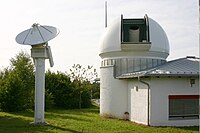
Photo from wikipedia
Global navigation satellite system reflectometry (GNSS-R) altimetry has great potential to provide high spatial–temporal resolution sea surface heights (SSHs) at low cost. Interferometric phase measurements between direct and reflected signals… Click to show full abstract
Global navigation satellite system reflectometry (GNSS-R) altimetry has great potential to provide high spatial–temporal resolution sea surface heights (SSHs) at low cost. Interferometric phase measurements between direct and reflected signals can be used for altimetry retrieval to achieve high-precision solutions. The motions of the medium Earth orbit (MEO) satellites cause interferometric phase change rapidly, which would increase the probability of occurrence of the phase unwrapping errors than the case of the geosynchronous Earth orbit (GEO) satellite. In order to overcome this problem, we propose a coastal GNSS-R altimetry algorithm using the signals from Quasi-Zenith Satellite System (QZSS) GEO satellite. Precise SSH variations can be achieved using the interferometric phase measurements without ambiguity fixed. We also perform coastal experiments on a trestle using a specialized GNSS-R setup to verify our algorithm. It is composed of an intermediate frequency (IF) data collector and two antennas. The up-looking antenna is used to receive direct signals, while the down-looking antenna receives the signals reflected from the sea surface. Raw IF data sampled at 62 MHz are collected and processed to derive interferometric carrier phase delay measurements using a self-developed software-defined receiver. Approximately 7 h of reflector heights are retrieved at 1-min intervals and the solutions are evaluated via comparison with measurements provided by a 26-GHz altimetry radar located near the GNSS-R setups. The results show that the root mean square error (RMSE) of sea level estimation is about 1.4 cm by using the QZSS GEO data.
Journal Title: IEEE Geoscience and Remote Sensing Letters
Year Published: 2022
Link to full text (if available)
Share on Social Media: Sign Up to like & get
recommendations!